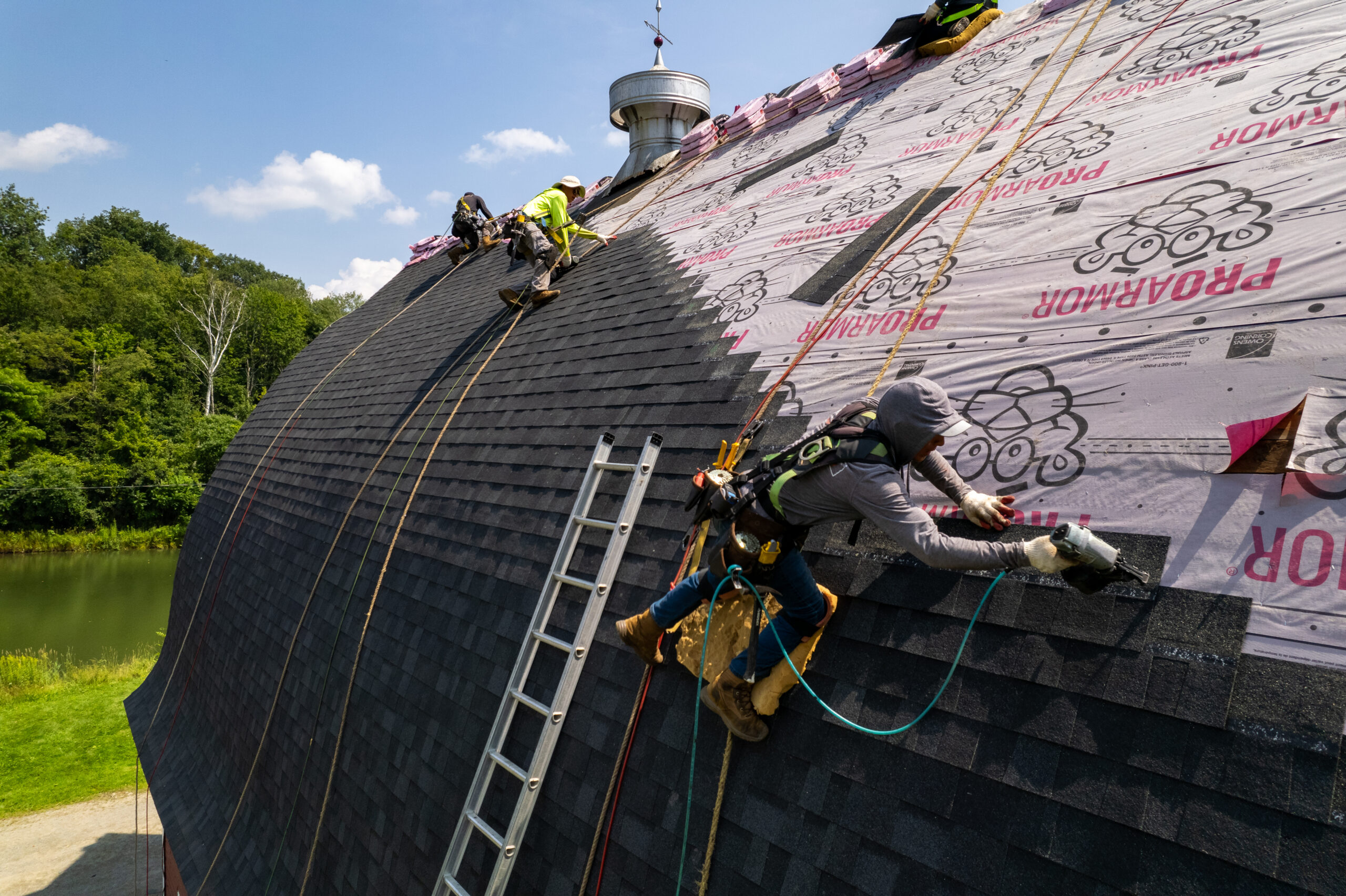What are the OSHA Requirements for Roof Safety?
Roofing is a vital aspect of construction, but it also comes with inherent risks, which is why the Occupational Safety and Health Administration (OSHA) has specific requirements and guidelines in place to ensure the safety of roofers and prevent accidents in the roofing industry.
Whether you’re working on a commercial building or a residential home, OSHA’s regulations related to fall protection, personal protective equipment (PPE), ladder safety, hazard communication, training requirements, electrical safety, and other relevant aspects still apply. The goal is to prevent accidents, injuries, and fatalities in all roofing work settings.
In this article, we’ll explore OSHA’s roofing safety best practices, ranging from personal protective equipment (PPE) to fall protection and more.
OSHA Required Roofing PPE (Personal Protective Equipment): Shielding Roofers from Hazards
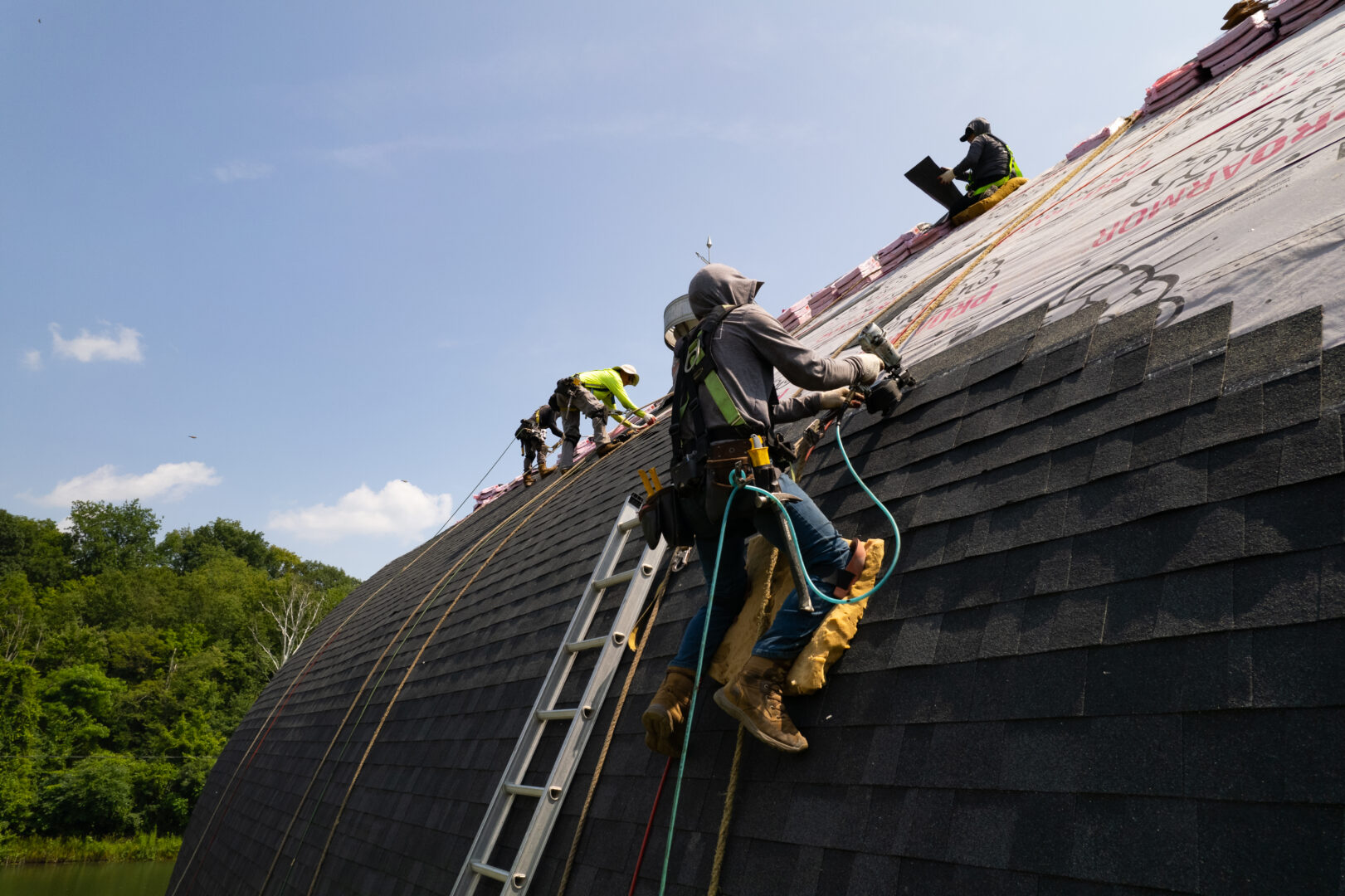
Personal Protective Equipment (PPE) is the first line of defense against potential roofing hazards. OSHA mandates the use of specific PPE to safeguard roofers during construction activities. This includes at a minimum hard hats, eye protection, hearing protection, gloves, and non-slip footwear to safeguard against potential hazards.
What PPE is Required for Roofing?
Hard Hats & Safety Helmets:
Protecting the head from falling debris, tools, and other hazards is crucial. Hard hats should be worn at all times on the job site when applicable (select residential roofing projects do not require hard hats for example).
Face & Eye Protection:
Goggles or safety glasses shield the eyes from dust, chemicals, and flying debris generated during roofing tasks.
Hearing Protection:
Prolonged exposure to loud noises, such as power tools, can lead to hearing damage. Earplugs or earmuffs should be worn to mitigate this risk.
Respiratory Protection:
If roofers are exposed to airborne contaminants, such as dust or fumes, respiratory protection may be required. OSHA’s respiratory protection standards outline the requirements for proper respiratory equipment and use. If exposed to airborne contaminants, such as asbestos or silica, proper respiratory protection equipment is essential.
Gloves:
Different roofing tasks require specific gloves, whether it’s heavy-duty gloves for handling materials or cut-resistant gloves for precision work.
Non-Slip Footwear:
Roof surfaces can be slippery, especially in wet conditions. Sturdy, slip-resistant footwear prevents falls.
OSHA Fall Protection Standards: Preventing Rooftop Accidents
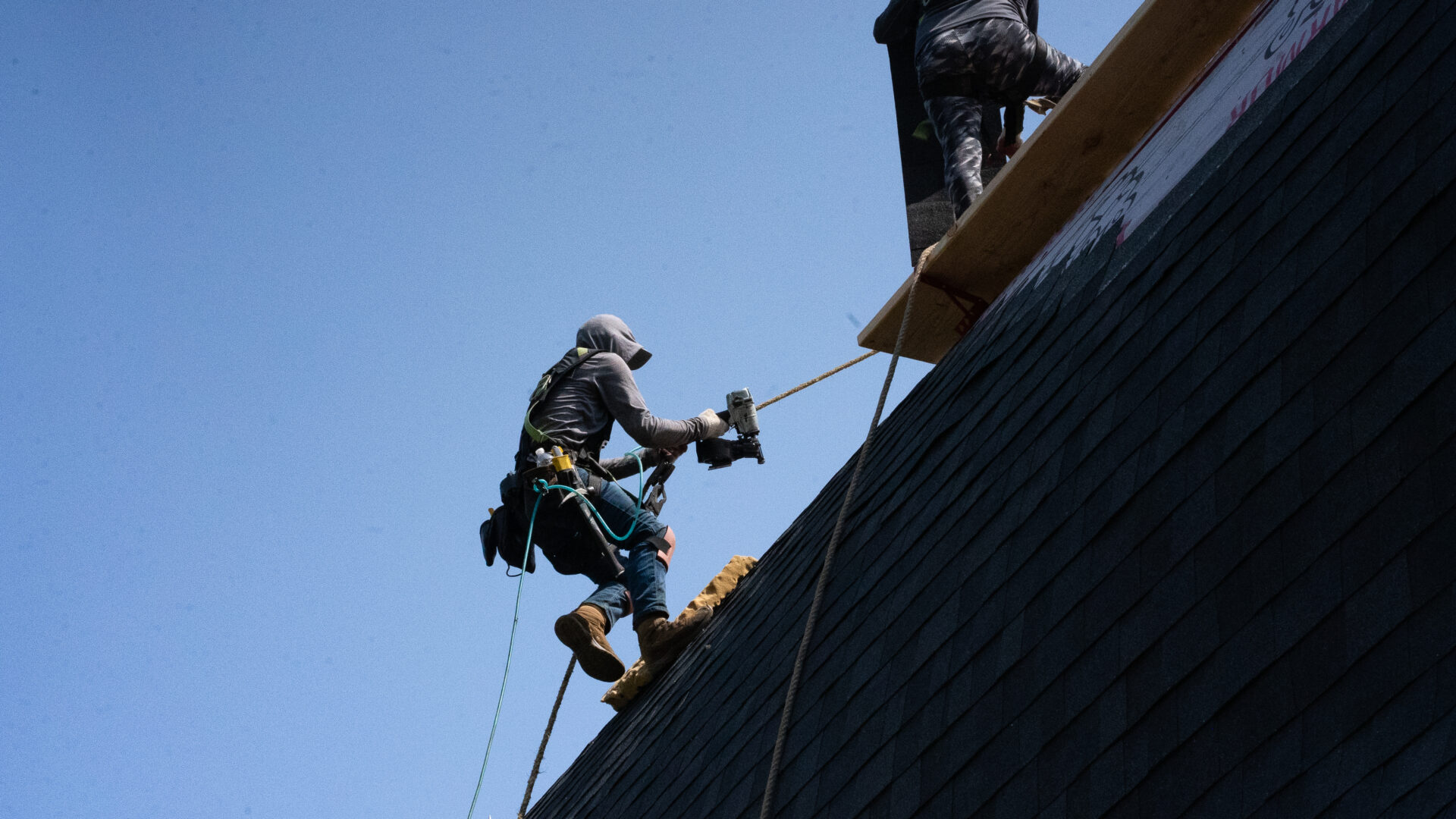
OSHA’s fall protection standard is one of the most critical OSHA roofing requirements. It requires employers to provide fall protection systems for workers who are working at heights of 6 feet or more above lower levels. This can include the use of guardrails, safety nets, or personal fall arrest systems (PFAS) such as harnesses and lanyards.
What are the OSHA Regulations for Fall Protection on a Roof?
Roof Guardrails:
OSHA requires the installation of guardrails on roofs where workers are exposed to fall hazards. Guardrails serve as a physical barrier along roof edges to prevent accidental falls. These guardrails should be at least 42 inches high and capable of withstanding a certain amount of force to ensure they effectively prevent falls.
Roof Edge Protection Requirements:
In situations where guardrails are not feasible, employers must implement other forms of fall protection such as safety nets or personal fall arrest systems (PFAS). Safety nets, placed under the work area, catch falling workers or debris. PFAS includes harnesses and lanyards that secure workers to anchor points, arresting falls.
Fall Arrest Systems:
When working at heights of 6 feet or more, roofers are required to use fall arrest systems. This includes wearing a full-body harness that’s securely attached to a lifeline or lanyard. The other end of the lifeline/lanyard should be anchored to a secure point to prevent workers from falling to the ground. It is also important to inspect personal fall arrest systems (PFAS) regularly for wear and tear, ensuring their effectiveness.
Roof Anchors:
Roof anchors are essential for attaching lifelines and lanyards in a fall arrest system. They need to be designed and installed by a qualified professional. Roof anchors should be able to withstand the required loads and provide reliable attachment points for fall protection equipment.
OSHA Ladder & Scaffolding Safety: Secure Access to the Roof
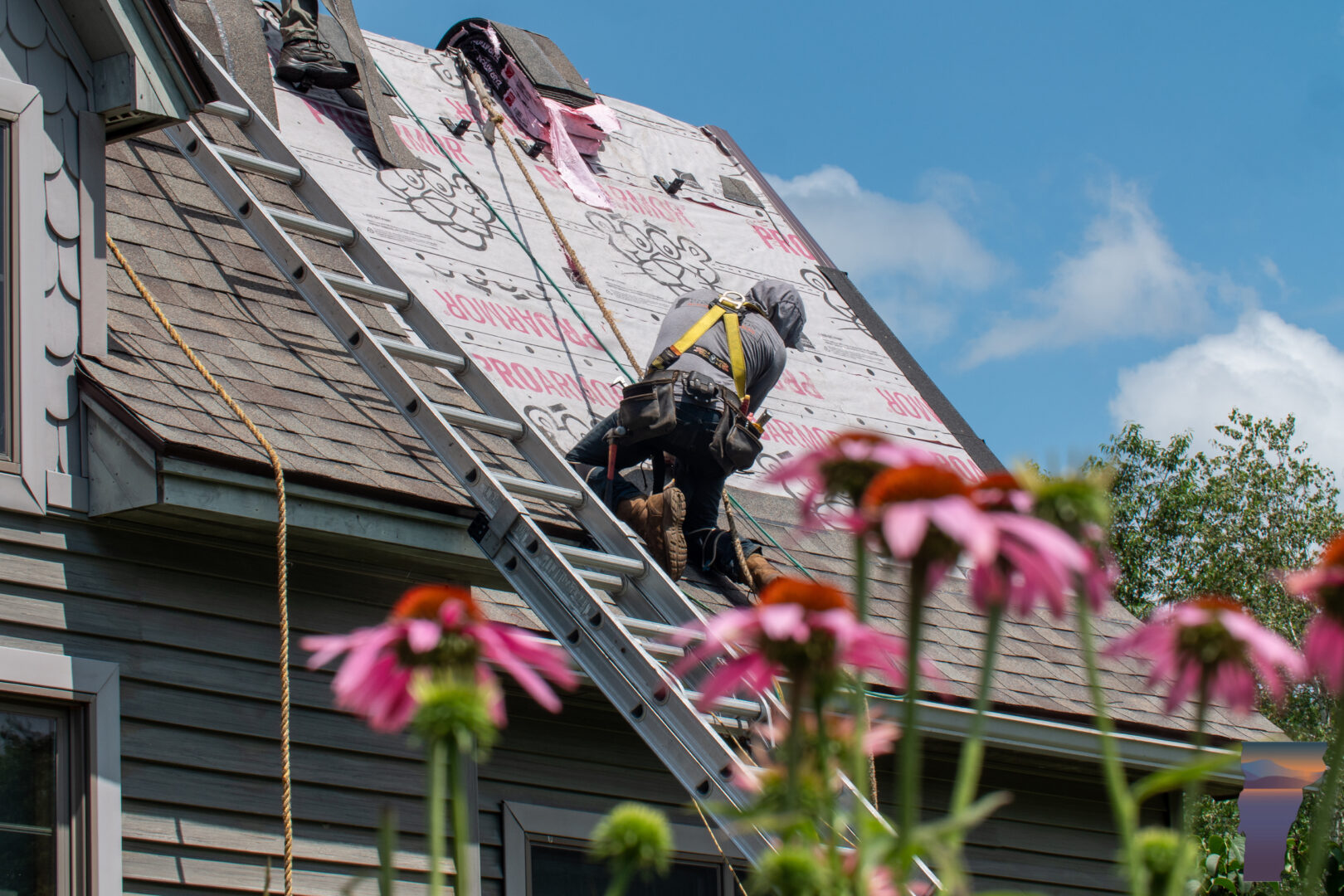
Roof access refers to the means by which workers enter and exit the roof area. OSHA roofing requirements aim to ensure that roof access is safe and secure to prevent accidents during ascent and descent. The choice between ladders and scaffolding for roof access depends on the nature of the roofing project, the height of the roof, and other factors. Regardless of the access method chosen, ensuring proper training, regular inspections, and compliance with OSHA’s guidelines are essential to maintaining a safe work environment for roofers.
What are the OSHA Standards for Ladder Roof Access?
When a ladder is used for roof access, it must be placed with the top resting against a surface that provides adequate support to prevent the ladder from sliding backward while a worker is climbing. The ladder should also extend at least three feet above the landing surface (e.g., roof edge) to provide a secure handhold for workers transitioning from the ladder to the roof or other ladder sections. Finally, ladders should be set at the proper angle to ensure ladder security and reduce the risk of tipping backward.
What are the OSHA Requirements for Ladders?
Ladder Selection:
When selecting ladders for roof access or any other task, certain factors should be considered to ensure safety, including type of ladder, ladder material, and duty rating. Choose the appropriate type of ladder for the specific task. For roof access, extension ladders are commonly used due to their adjustable height. Ladders should also be made of materials suitable for the work environment. For example, fiberglass ladders are non-conductive and safe for electrical work. Ladders are also classified by duty rating, indicating their weight capacity. Select a ladder with a duty rating that accommodates the weight of the worker and any tools or materials.
Ladder Placement & Stability:
Proper ladder placement and stability are essential to prevent accidents. Always place the ladder on a stable and level surface. If the ground is uneven, use ladder levelers to ensure stability. Ladders must also be secured to prevent sliding or tipping using ladder stabilizers or tie-offs if necessary. Angle is another important factor. For extension ladders, the base should be placed one foot away from the wall for every four feet of ladder height.
Ladder Usage:
Safe ladder usage is crucial for preventing falls and injuries. Prior to usage, OSHA requires that employers provide employees with proper safety training for ladder usage. At all times when ascending or descending the ladder, it is essential for roofers to maintain three points of contact (two hands and one foot, or two feet and one hand), and to always face the ladder while climbing up or down. All employees must also use a tool belt or a rope to bring tools up a ladder, never carrying heavy tools in their hands while climbing.
Ladder Inspection:
Regular ladder inspections help identify defects and ensure safe usage. Roofers should always do a pre-use inspection to inspect ladders for any visible defects, such as broken rungs, missing parts, or signs of damage. If any ladder is found to be defective, they should be removed from service immediately and tagged as “Do Not Use” to prevent accidents.
What are the OSHA Requirements for Scaffolding?
While not always applicable to all roofing projects, scaffolding can provide safe and stable access to roofs. The OSHA requirements for scaffolding emphasize proper assembly, stability, and usage at all times. However, scaffolds should not be used during inclement weather, strong winds, or other adverse conditions that could compromise stability and safety.
Safe Assembly:
Scaffolding used for roof access must be designed, erected, and assembled by qualified personnel in accordance with OSHA standards and manufacturer guidelines. When setting up scaffolding, it is important to maintain adequate clearance around the scaffold to prevent contact with nearby structures, power lines, or other hazards.
The scaffold must also have a stable and level base to prevent tipping or collapsing, using adjustable screw jacks or base plates to ensure proper support on uneven surfaces. Planks and platforms should also always be securely fastened to prevent dislodging, and scaffolds higher than 10 feet must have guardrails on all open sides and ends. Toeboards must also be installed along the edge of the scaffold to prevent tools or materials from falling.
Platform Strength:
Scaffold platforms should be able to support their own weight plus at least four times the intended load. However, scaffolds should not be overloaded with excessive materials, tools, or equipment beyond their rated capacity. Scaffolding should also be inspected before each use to identify any defects or damage that could compromise its strength and stability.
Access Points:
Scaffolds should have safe access points for workers to reach the scaffold platform. Stair towers, portable ladders, or integral ladders with proper rung spacing and clearances can be used. Workers on scaffolds above 10 feet must also use appropriate fall protection, such as guardrails, personal fall arrest systems (PFAS), or safety nets, to prevent falls while accessing and using the platforms.
Hazard Communication & Training: Equipping Roofers with Knowledge
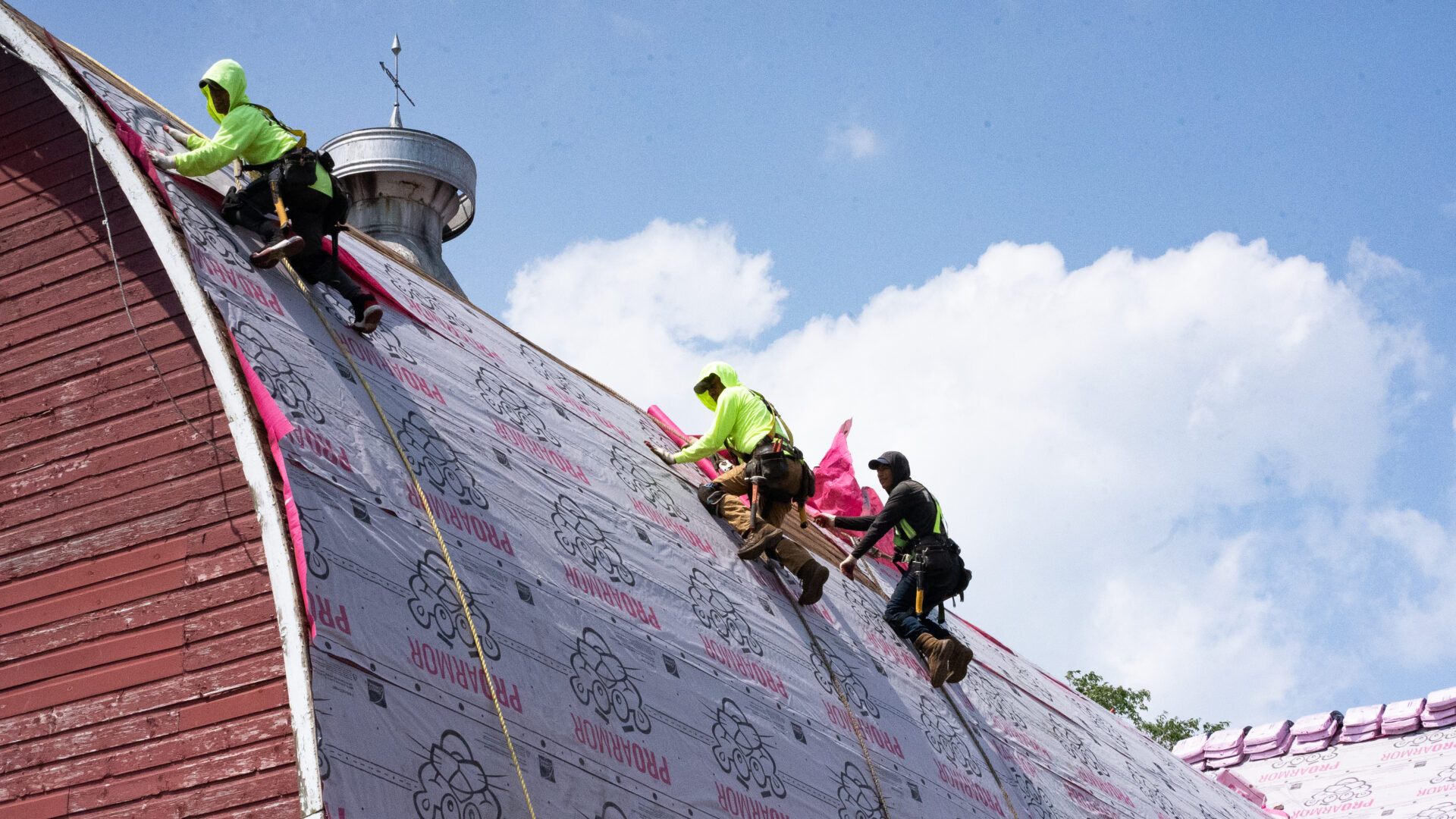
Hazard communication and training are two more essential OSHA roofing requirements. OSHA’s hazard communication standards are designed to ensure that workers are informed about the hazardous chemicals and materials they may encounter on the job, and that they receive proper training to work safely in these environments.
Hazard Communication:
Effective communication of potential hazards is crucial to maintaining a safe work environment. OSHA mandates clear hazard communication protocols, including labels, signage, and material safety data sheets (MSDS). Roofers often encounter hazardous materials such as adhesives, sealants, coatings, and solvents. These materials can pose health risks if not handled properly. Employers in the roofing industry need to identify any hazardous materials used in roofing work; provide workers with the proper training on how to handle, store, and dispose of these materials safely; and ensure that workers have access to MSDS for any chemicals they may be exposed to.
Electrical Safety:
If roofing work involves electrical components or working near power lines, OSHA’s electrical safety standards apply. These standards help prevent electrical hazards and ensure workers are protected from potential shock and electrocution.
Training Requirements:
Roofers must undergo comprehensive training on equipment usage, fall protection, hazard recognition, emergency procedures, and more. Training should be conducted in a language and manner that workers can understand, and should be continuous through regular training refreshers to keep roofers informed about new safety protocols and industry best practices.
Emergency Action Plans:
Employers need to have well-defined emergency action plans that outline procedures for responding to various emergencies on the job site such as fires, severe weather, or other unexpected events. Roofing employees should always be trained on these emergency action plans and kept informed on relevant updates.
Conclusion: Safety First for Successful Roofing Projects
These are just a few of the key OSHA requirements that pertain to roofing safety. It’s important for roofing companies and workers to be well-versed in OSHA regulations and to implement proper safety practices to protect the well-being of everyone involved in roofing projects. Please note that regulations may change over time, and it’s important to always refer to the official OSHA standards and guidelines for the most up-to-date and accurate information.
At Vermont Construction Company Roofing Division, we recognize that the well-being of our roofers is integral to the success of our projects. Adhering to OSHA roofing requirements and safety guidelines not only ensures that our team operates in a secure environment, but also contributes to the quality and efficiency of our work. Through unwavering commitment to safety, we uphold our promise of excellence in every roofing project we undertake.
